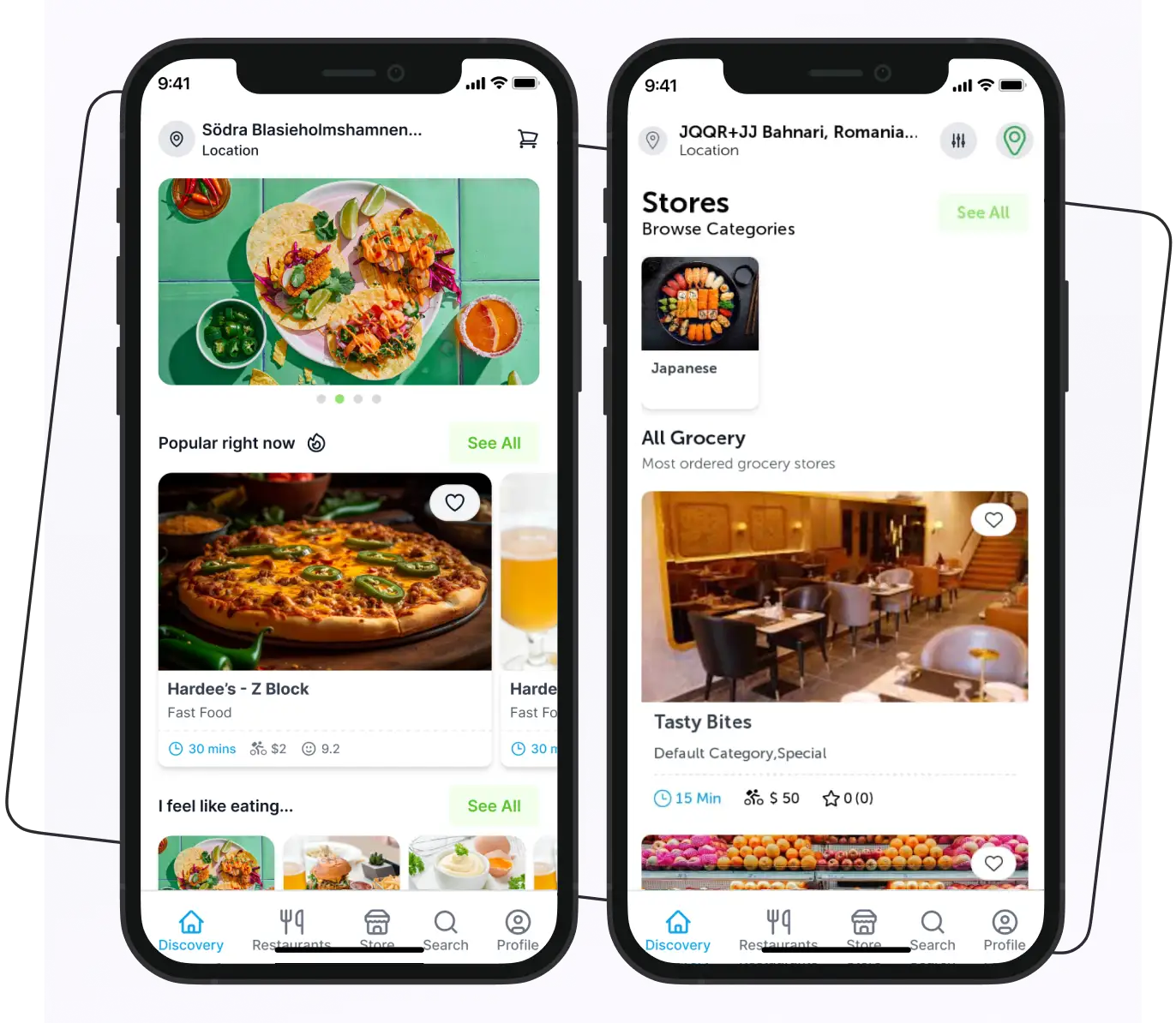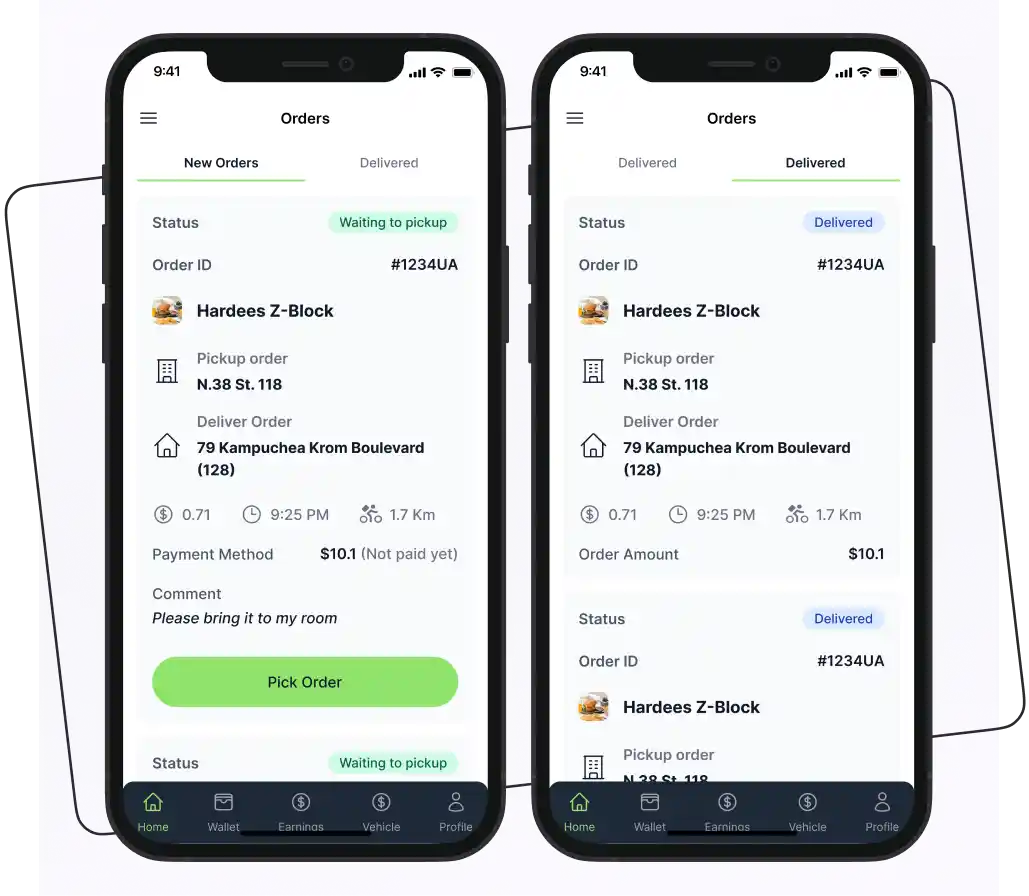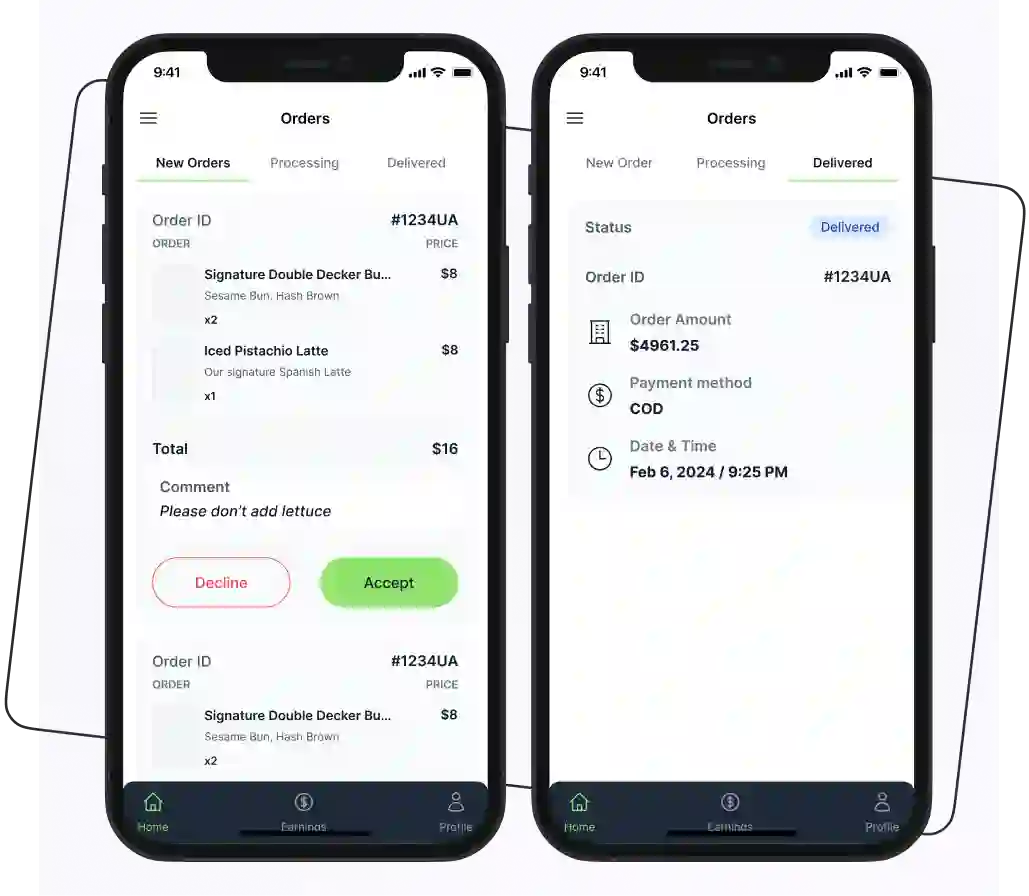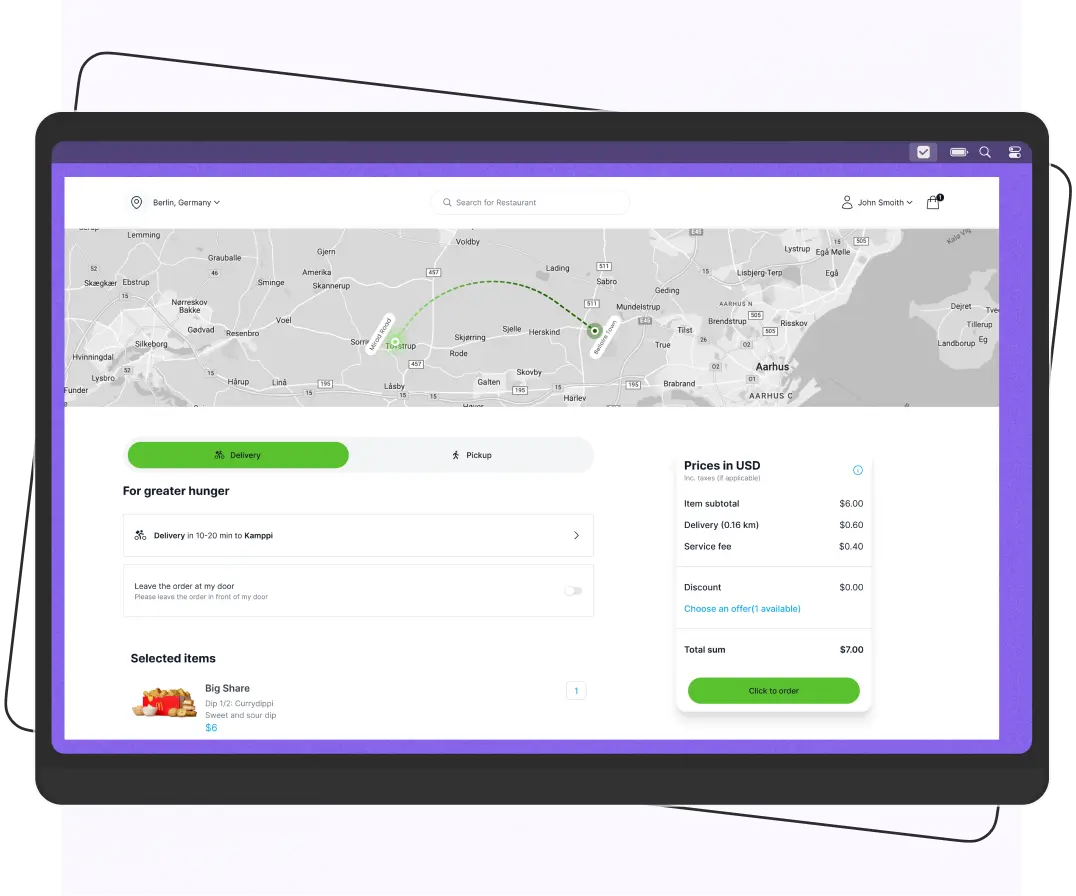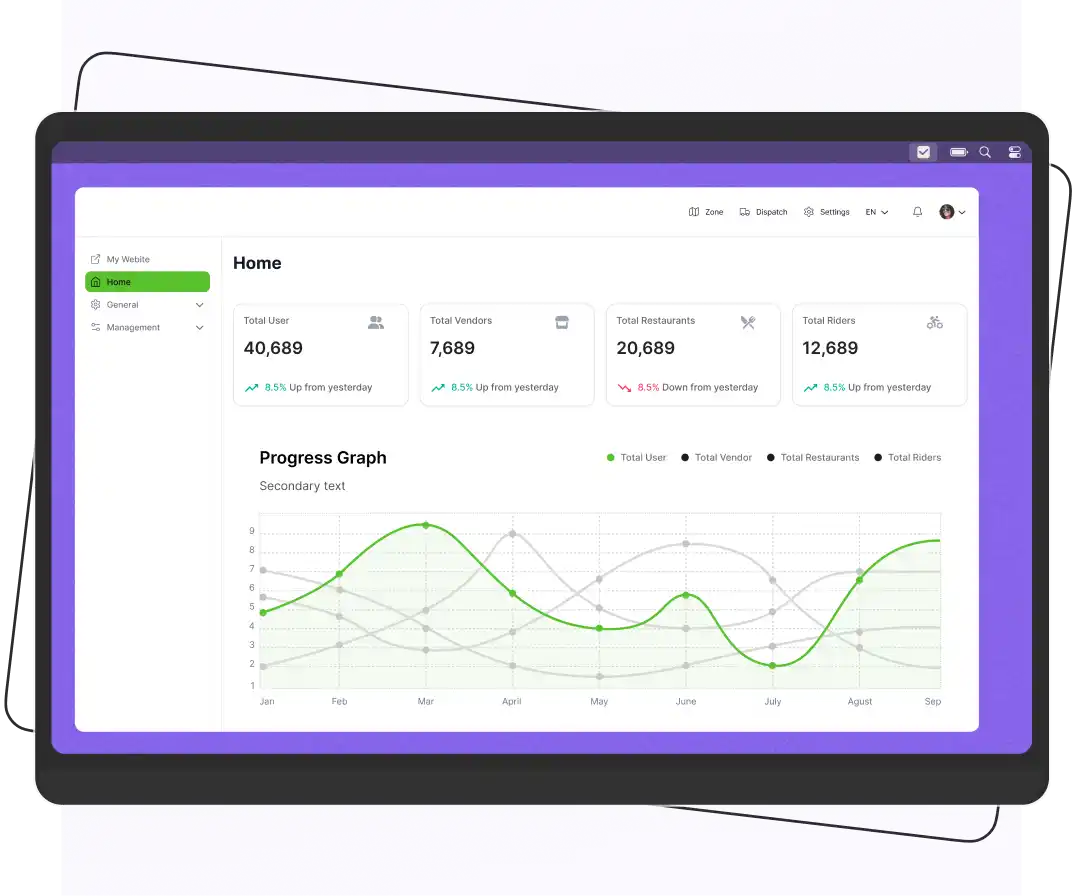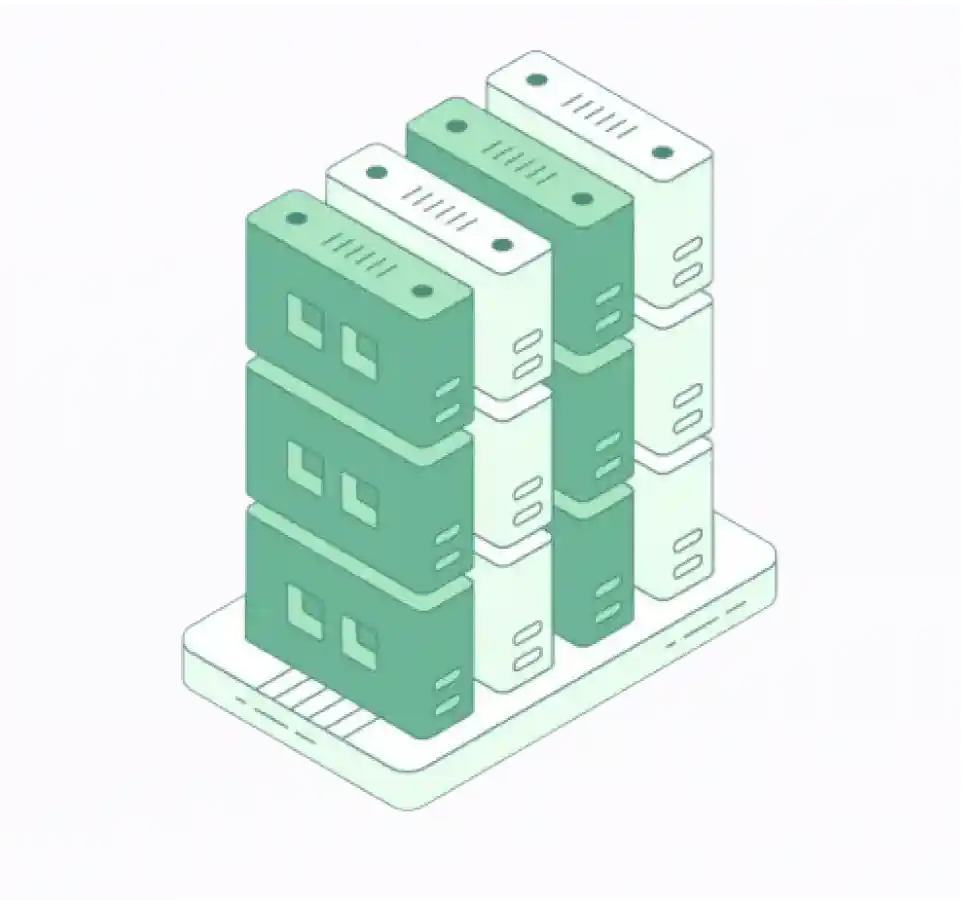
Key Takeaways
- Top Platforms: Toast, Square Online, Bbot, Popmenu, and Menufy are leading choices for restaurants looking to streamline online ordering and delivery.
- Core Benefits: These systems help increase revenue, reduce fake orders, automate processes, and improve customer satisfaction.
- Essential Features: Look for platforms with POS integration, real-time tracking, menu customization, multiple payment gateways, and marketing tools.
- Pricing Overview: Options range from free or low-cost (Square, Toast Starter Kit) to premium plans (Popmenu at $349/month), offering flexibility for all restaurant sizes.
- Choosing the Right System: Consider ease of use, mobile-friendliness, integration with existing tools, support quality, and pricing structure.
- Monetization Tips: Generate revenue through delivery charges, commissions, advertising, premium listings, and subscription models.
- Development Costs: Building a custom food ordering system costs between $20,000–$60,000+, depending on features and region.
- Need a Custom Solution? Enatega offers fully customizable and scalable food ordering platforms tailored for restaurants and delivery startups.
From food trucks to fine dining, one thing unites every successful restaurant in 2025 is a powerful online food ordering system.
Now, customers expect speed, simplicity, and digital convenience right from their smartphones. The global food delivery market is projected to exceed $97 billion by 2032, and the restaurants that adopt the right tech early are already ahead of the curve.
But here’s the problem: with dozens of food ordering platforms out there, choosing the right one can feel overwhelming.
So we’ve made the decision-taking phase easy for you.
In this blog, we explore the 5 best online food ordering systems for restaurants, from budget-friendly options for small eateries to platforms designed for growing chains.
We’ll compare features, pricing, integrations, and more. So, you can find the perfect fit for your restaurant and start turning more orders into revenue.
What is an Online Ordering System?
The online ordering system for restaurants is a digital food ordering platform that allows customers to place orders online. Customers can browse several restaurants, select items, customize the menu, select the delivery option, etc, and then place an order.
In addition, restaurants can use food delivery management software to connect with more customers and provide convenient and timely delivery of their orders.
The main objective of the online ordering system for restaurants is to:
- Streamline the process and make it more efficient.
- Automate all the operations.
- Provide a quicker service to customers.
- Increase customer loyalty by providing deals and discounts.
- Help you in managing your restaurant inventory.
- Help you track the orders.
Moreover, online ordering systems are the best option for restaurants looking to stay competitive in the food delivery market.
Supercharge your deliveries with Enatega.
Launch NowHow Does an Online Ordering System Work?
The online ordering system provides convenience and ease of use, making the entire ordering process easy. Let’s look at the steps below to understand how restaurant delivery platforms work.
Step 1: Customers browse the menu on their smartphones or any other digital device.
Step 2: They choose what they want to order and give special instructions if they want to add.
Step 3: Customers choose the food delivery payment method from the multiple options. Then, the order is placed.
Step 4: The order details are sent to the restaurant, and their staff start working on it.
Step 5: When the order is ready, the rider picks it up.
Step 6: The rider delivers the food to the customer’s location, or the customer picks up the food from the restaurant.
Best Food Ordering Systems for Restaurants
What do restaurants use for online ordering?
Below are some best food ordering systems for restaurants.
| Feature | Toast | Bbot | Square Online | Popmenu | Menufy |
| Pricing | Starts at $0/month; add-ons vary | Custom pricing; usually $100+/mo | Starts at $0/month with transaction fees | Starts at $49/month | Starts at $1.50/order (no monthly fee) |
| POS Integration | Yes, integrated POS | Yes, integrates with major POS | Yes, integrated POS | Yes, integrates with POS | Yes, integrates with some POS systems |
| Menu Customization | Yes, highly customizable | Yes, customizable | Yes, with drag-and-drop editing | Yes, customizable with design focus | Basic customization |
| Order Tracking | Real-time updates | Real-time tracking | Yes, with Square’s order manager | Real-time order status | Limited tracking |
| Marketing Tools | Built-in email & SMS marketing | Limited | Basic marketing tools | Advanced marketing tools included | No built-in marketing |
| Customer Data Access | Yes | Yes | Yes, through Square’s analytics | Yes, with a focus on customer data | Limited insights |
| Payment Processing | Integrated payments | Supports various payment methods | Integrated with Square | Integrated payments | Integrates with Stripe or PayPal |
| Third-Party Delivery Support | Yes, integrates with delivery apps | No | Yes, partners with delivery apps | Limited | Limited delivery support |
| Customer Support | 24/7 support | 24/7 support | Business hours, chat, and phone | 24/7 support | Limited support hours |
| Target Businesses | Small to large restaurants | Bars, breweries, and restaurants | Small to medium businesses | Independent restaurants | Small businesses and independents |
1. Toast
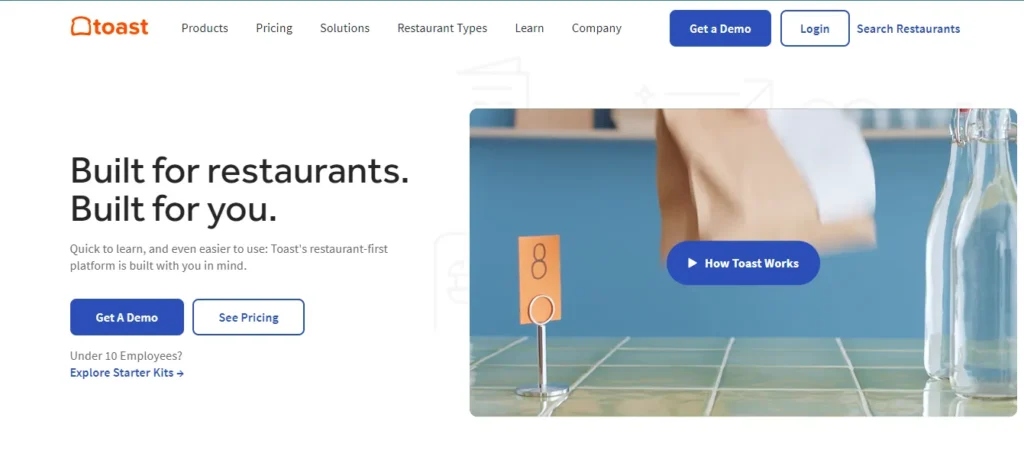
Toast is a cloud-based restaurant point of sale and management system. It is a powerful online ordering system that is designed to help restaurant business owners run their business more efficiently.
More than 120,000* restaurants trust Toast for their business operations. From POS to payroll, they can manage all, so the businesses can focus on what they do best.
Moreover, Toast is a great choice for food trucks, cafes, bakeries, coffee shops, hotels, and restaurants.
Toast Features
- Accessible from anywhere
- 24/7 support
- 200+ integrations
- Customizable hardware setup
- Email marketing
- Order management
- Inventory management
- Employee management
- Kitchen display system
| Pros | Cons |
| Flexible pricing plans | May have limited support for troubleshooting or specific issues |
| Extensive integration with other restaurant tools | Integration with third-party apps can be challenging and time-consuming |
Toast Pricing
Three pricing plans are offered by Toast POS.
- Starter Kit: Starting at $0 /month
- Point of Sale: Starting at $69 /month
- Build Your Own: Custom pricing
2. Bbot
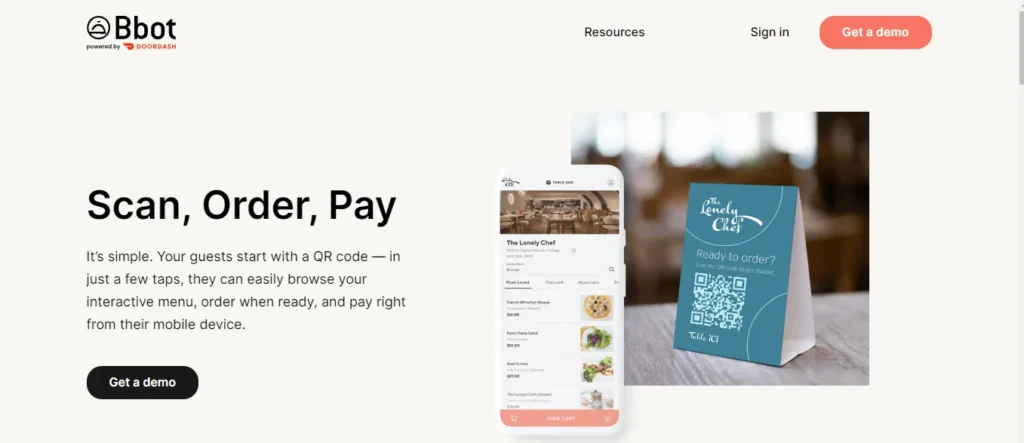
Bbot is a software tool for restaurants, hotels, and breweries that helps them manage online orders and payments. Many restaurants use Bbot for takeout, curbside pickup, and delivery. Bbot offers digital ordering but doesn’t include features for customer loyalty programs or marketing, focusing solely on the ordering experience.
Bbot Features
- Multi-menu support
- Easily integrate with Toast and Square
- Menu customization
- Group ordering
| Pros | Cons |
| Real-time order tracking | Staff may require training to use the system |
| Easy-to-use platform |
Bbot Pricing
Bbot charges a monthly subscription fee of $50/month with no commission rates.
3. Square Online

Square Online is an all-in-one platform that can efficiently manage your business operations. It helps businesses to run their business from anywhere. This POS helps businesses of all sizes to improve their processes and run their business efficiently.
With transparent pricing and no hidden fees, Square is an attractive choice for entrepreneurs and established businesses.
Square Online Features
- Built-in SEO tools and integrations
- Personalized promos and coupons
- Square gift cards
- Loyalty programs
- Website builder
| Pros | Cons |
| Offers a free plan and affordable hardware options | Limited customization |
| Strong integration with Square Online | Advanced features require paid plans |
| Offer a free trial | May not be as well-suited for large or complex businesses with specific needs |
Square Online Pricing
Square POS offers three plans, such as:
- Free: $0 (no monthly fees)
- Plus: $29 (billed annually)
- Premium: $79 (billed annually)
4. Popmenu
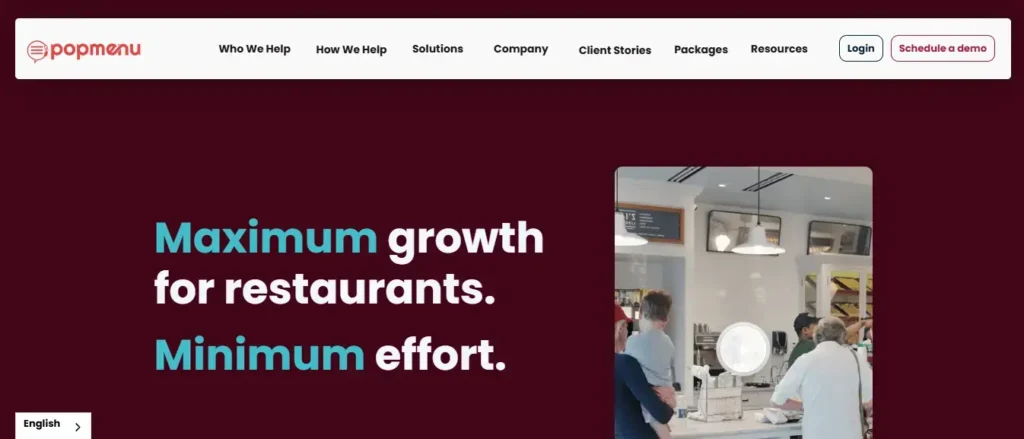
Popmenu is another well-known food ordering system that allows you to have full control over the online ordering process. It helps restaurants to customize their menus and optimize customer engagement.
With features like interactive menu designs, real-time order tracking, and integrated marketing tools, Popmenu streamlines the ordering experience for both customers and restaurant staff. In addition, Popmenu helps 10,000+ restaurants, big and small.
Popmenu Features
- Automate personalized marketing campaigns
- Real-time updates
- POS integration
- Google business profile integration
- Direct online ordering
| Pros | Cons |
| Commission-free online ordering | Long-term contracts |
| Social media integration | Lack of a custom mobile app |
Popmenu Pricing
Popmenu offers a pro plan ($349 per month or $3,769 per year). This premium plan includes all features, such as:
- Interactive online menus
- Website optimized for search engines
- Automated capture of guest contacts
- Email and text marketing
- Dish reviews you control
5. Menufy
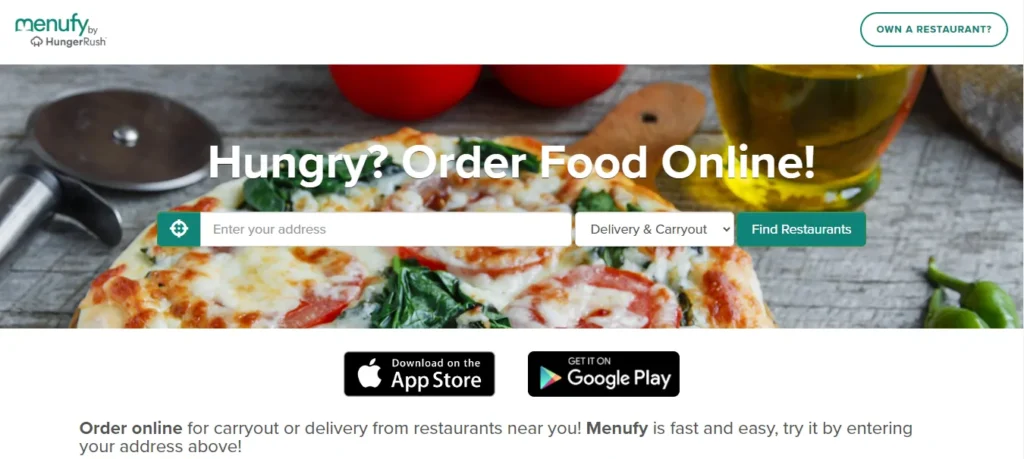
Menufy is another online food ordering system for restaurants that provides restaurants with a branded website to facilitate takeout and delivery orders. Designed to integrate easily with restaurant operations, Menufy handles the technical aspects of online ordering, enabling restaurants to reach more customers through a customized online presence.
Menufy Features
- Custom restaurant website
- Creating and scheduling email marketing campaigns
- Refunding orders
- Access customer data
| Pros | Cons |
| Free website creation | Charges a transaction fee |
| No long-term contracts | Potential dependence on a third-party platform |
Menufy Pricing
Menufy offers a simple pricing model that is based on per-order fees without monthly or yearly commitments.
Per-Order Fee: Menufy charges a transaction fee on each order, which restaurants can choose to absorb or pass on to customers. This fee is approximately $1.75 per order. Additionally, Menufy includes payment processing fees at a rate of 2.75% plus $0.30 per transaction.
No Monthly Fees: For restaurants looking to avoid subscription models, Menufy’s pay-as-you-go structure remains appealing. There are no monthly fees for core ordering services, making it a flexible choice for smaller or newly established restaurants.
How to Choose an Online Ordering Platform for Restaurants?
Below are some tips to help you make the right decision for picking the best online ordering platform for your restaurant.
- Look for a platform that is intuitive for both customers and staff.
- Ensure the platform is mobile-friendly, as many customers order via smartphones.
- Choose a platform that integrates easily with your existing Point of Sale (POS) system to minimize errors.
- The platform should allow you to easily update your menu, including pricing and availability.
- Look for options to customize the look and feel of the ordering interface to reflect your restaurant’s branding.
- Ensure the platform provides reliable customer support, including live chat, email, or phone support.
- Understand the pricing model, whether it’s a monthly subscription, commission-based, or a combination.
- Look for reviews and testimonials from other restaurant owners. Research the platform’s reputation to ensure reliability and quality.
What are the Advantages of an Online Food Ordering System For Restaurants?
The online ordering system provides many long-term benefits to restaurants. So, let’s look at them and realize the importance of online food delivery systems.
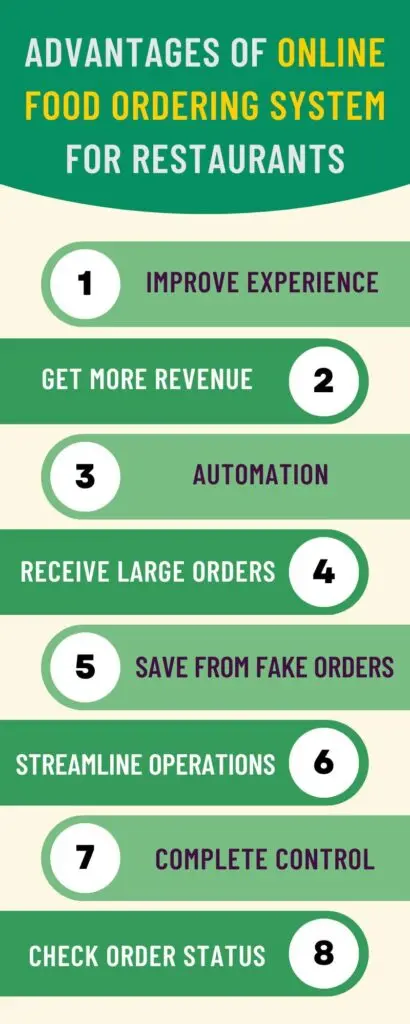
Improve Experience
The best online ordering system for restaurants gives customers a better experience. It is a hassle-free and easy way to order food online. With the online ordering system, customers can order food anytime and from anywhere with just a few taps on their mobile phones, and the food is delivered to their doorstep.
Get More Revenue
It is a great way to get more revenue for your business. Customers can use food ordering systems more than traditional ones, especially on busy schedules and bad weather days. Therefore, it is the best chance to get more sales and boost profit for your business.
Automation
An online food ordering system for restaurants is automatic. Therefore, you don’t need to hire many staff to manage your operations, such as accounts. Also, you can save your employer time by taking orders on the phone.
Sometimes, the customers find the restaurant’s number busy and turn to another restaurant. So, there is a huge chance of losing the customer. However, this can be avoided with the help of a restaurant order system.
Receive Large Orders
Customers can easily place large orders with an online food ordering software. So, it is a great way to increase sales and make significant revenue.
However, if you are new to the food delivery industry and confused about how to serve more customers via an app, you can consult Enatega.
Supercharge your deliveries with Enatega.
Launch NowSave from Fake Orders
It is an ideal solution to save yourself from fake orders. Sometimes, restaurants face this problem when they take orders using traditional methods. They get a lot of phone calls when customers place orders, and when it’s time to deliver the food, they don’t receive calls. Due to this issue, the food and the restaurant’s time are also wasted.
But this situation can be changed with a food ordering system. Customers provide complete information, such as name, address, and number. So there is no room for placing an order and disappearing.
Streamline Operations
With an online restaurant ordering platform, run all the operations smoothly, from order management to real-time tracking. Also, it helps to reduce the burden on the restaurant staff. Thus, they focus on other responsibilities rather than doing the same task for a long time.
Complete Control
The best part of using the restaurant’s online ordering software is completely controlling everything. You can customize the menu, add images, pricing, and details that give your customers a better experience.
In addition, you can keep track of everything that is going on in the kitchen and the dining hall with a restaurant ordering system.
Check Order Status
The restaurants can check the status of their food order, whether it has been delivered or not. It helps them manage all the records automatically. Also, the customers track their orders to see how far the rider is and how long it will take to deliver the food.
Must-Have Features in a Restaurant Ordering System
The online ordering system is a crucial part of the restaurant. With top-notch features of the food ordering system, restaurants can succeed and improve their business.
Therefore, if you are wondering what features are included in the restaurant order system, then look at the given features.
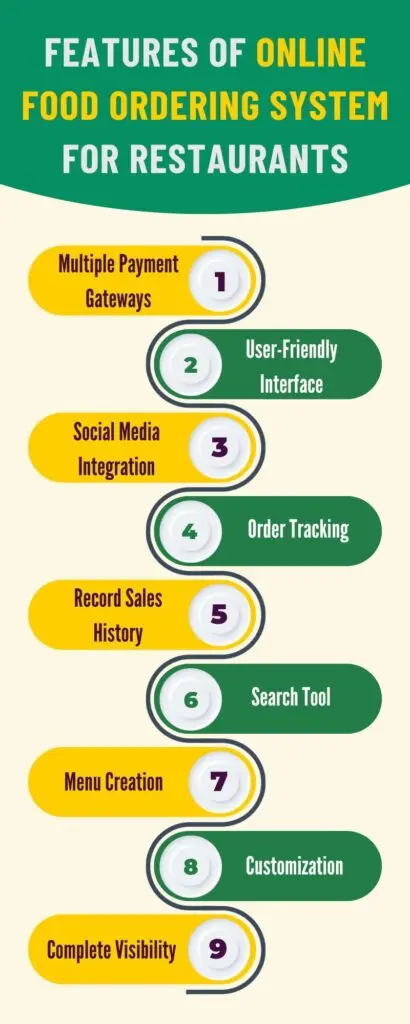
Multiple Payment Gateways
Always provide multiple payment options to customers so they can quickly pay the bill without hassle. Also, make the payment process method easy and don’t make it complex for the customers.
User-Friendly Interface
Website online ordering systems should have a user-friendly interface. Customers can easily browse menus, check restaurant information, and place orders online when the ordering system has a user-friendly interface.
Social Media Integration
Social media integration is necessary for an online ordering system for restaurants. When you integrate social media, it will increase your order rate ten times more than before.
Customers also share their photos and provide feedback on these platforms to help others know about your business.
Order Tracking
The online food delivery management app should include an order tracking feature to track the deliveries. This feature helps restaurants and customers to track their orders.
Record Sales History
Having an online food ordering system records all the transactions. With the help of this feature, restaurants can record their sales history, the revenue they made, etc., for seamless operation of restaurants.
Search Tool
The restaurant operating system must provide an excellent user experience. The search feature is invaluable and allows customers to find menu items they are looking for easily.
Restaurants must include filters allowing customers to find vegetarian, gluten-free, and non-vegetarian meals quickly.
Menu Creation
It is the must-have feature of the food ordering system. The restaurant staff can create an online menu, alter prices, item descriptions, and more. The interface should be easy to update all the information without any help.
Customization
The best online ordering platforms for restaurants provide a customization feature. This feature allows customers to tailor their menu according to their choice. Also, they schedule deliveries for a specific time.
For example, if a customer orders a pizza, they can add a custom topping to a pizza, select the crust, and add any special delivery instructions for riders.
Complete Visibility
Prioritize order visibility when looking through the various online food ordering system options. In other words, you want to use a system that provides as much information about each order as possible.
For instance, you should be able to access information from the system about the types of food ordered, the customer’s name, address, and history of orders, as well as details about special requests, payment options, and order statuses.
How Much Does It Cost to Develop an Online Food Ordering System?
The cost of developing the online food ordering system depends on complexity. A basic online ordering system would cost between $20,000 – $40000. The price can also reach $50,000 to $60000 if you want your mobile app to be specifically designed with the essential features.
App developers with up to five years of expertise charge approximately $50,000 in Canada and $75,000 in the USA. Nonetheless, with five to ten years of app development experience, the designer charges between 55 to 70 thousand dollars in Canada and 100 to 112 thousand dollars in the USA.
Best Ways to Make Money from a Food Ordering System
Below are some best ways to help you make money from the food ordering system.

Delivery Charges: Implement a delivery fee for orders, especially for customers further away from the restaurant. This helps offset the costs of fuel, vehicle maintenance, and the time spent on deliveries.
Commission Charges: Charge restaurants a commission for each order placed through your food ordering platform. This is a common revenue model, with commissions typically ranging from 10-30% of the total order value.
Peak Pricing: Consider implementing dynamic pricing during peak hours, weekends, and special events. This allows you to capitalize on increased demand and charge higher rates when the system is busier.
Advertisements: Sell ad space on your platform to restaurants, food vendors, or complementary businesses. This can include banner ads, sponsored listings, or featured placements.
Premium Listings: Offer restaurants the option to purchase premium listings or enhanced visibility on your platform for an additional fee.
Subscription or Membership Fees: Charge restaurants a monthly or annual subscription fee to be listed on your platform and access advanced features.
FAQs
1. How do you create a food delivery system?
Below are some steps to help you create the food delivery system.
- Know your objective
- Understand your target audience
- Identify the app features
- Start development
- Testing
2. What are the three main food delivery services?
The three main food delivery services are:
- Uber Eats
- DoorDash
- Grubhub
3. What is a web-based ordering system?
A web-based ordering system is a software application that allows customers to place orders for products or services over the Internet, usually through a company’s website or mobile app.
4. Which model is best for an online food ordering system?
An integrated model is best for an online food ordering system. In this model, restaurants operate efficiently on the food ordering platform, whether or not they have delivery fleets.
5. What is the cheapest food ordering system for small restaurants?
The cheapest food ordering systems for small restaurants often include platforms like Square or Toast, which offer low-cost plans with essential features. Additionally, using apps like Uber Eats or DoorDash can be economical if commissions are manageable.
6. What system do restaurants use to take orders?
Restaurants use Point of Sale (POS) systems to take orders, which integrate order management, payment processing, and inventory tracking.
7. What is an online food ordering platform?
An online food ordering platform is a digital service that allows customers to browse menus, place orders, and make payments for food from restaurants via websites or mobile apps. Examples include Grubhub, DoorDash, and Uber Eats, which connect consumers with local eateries for delivery or pickup.
8. What is the best POS system for fast food restaurants?
The best POS systems for fast food restaurants are Toast and Square. These systems offer features like quick order processing, customizable menus, inventory management, and more, making them ideal for fast food service.
9. How to create online ordering for a restaurant?
To create online ordering for a restaurant, use a website builder with e-commerce features or a dedicated online ordering platform. Integrating a menu, payment processing, and delivery options. Ensure the system is user-friendly and mobile-responsive.
10. What is the best online food ordering service?
DoorDash and Uber Eats are the best online food ordering services due to their wide restaurant selections and delivery options. Grubhub is also a strong contender with a focus on urban areas and loyalty programs.
11. What do restaurants use to order food?
Restaurants use various systems to manage food orders, including:
- Point-of-sale (POS) systems
- Online ordering platforms
- Third-party delivery apps
12. How to start your food delivery service?
Here are some steps to help you start your food delivery service.
- Market research
- Select the business plan
- Get necessary licenses and permits
- Plan your menu
- Create a user-friendly app or website
- Launch your service
- Promote your service on social media platforms
13. Which food delivery service is best for restaurant owners?
The best food delivery service for restaurant owners often depends on specific needs, but popular options include:
- DoorDash
- Uber Eats
- Grubhub
- Postmates
14. Where do restaurants get their food?
Restaurants source their food from various suppliers, including:
- Wholesale Distributors: Companies that provide bulk food products and ingredients.
- Local Farmers and Producers: For fresh, seasonal ingredients, often emphasizing farm-to-table practices.
- Specialty Markets: For unique or high-quality ingredients.
- Importers: For international foods and specialty items.
Supercharge your deliveries with Enatega.
Launch NowConclusion
The convenience, efficiency, and accessibility of the online ordering system have become necessary and integral to the modern dining experience. These platforms will play a more significant role in shaping the future of the restaurant industry.
For restaurants looking to thrive in this industry, they must use an online ordering system. It is an important investment for your restaurant.
So, if you want to create an online ordering platform, consult the food ordering app development company, Enatega. We provide a food delivery solution that is 100% customizable and fully functional.
Book a free demo with us and get the best food ordering platform like Foodpanda clone.













 IOS
IOS Android
Android Web
Web